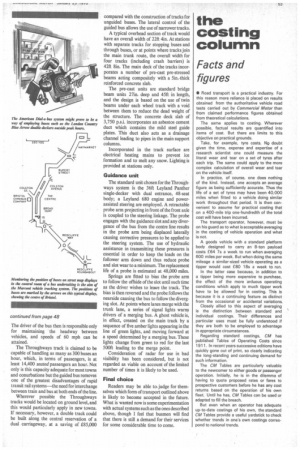the costing column
Page 55

If you've noticed an error in this article please click here to report it so we can fix it.
Facts and figures
• Road transport is a practical industry. For this reason more reliance is placed on results obtained from the authoritative vehicle road tests carried out by Commercial Motor than from claimed performance figures obtained from theoretical calculations.
The same applies to costing. Wherever possible, factual results are quantified into items of cost. But there are limits to this objective on practical grounds.
Take, for example. tyre costs. NQ doubt given the time, expense and expertise of a research scientist one could measure the literal wear and tear on a set of tyres after each trip. The same could apply to the more complex calculation of overall wear and tear on the vehicle itself.
In practice. of course, one does nothing of the kind. Instead, one accepts an average figure as being sufficiently accurate. Thus the life of a set of tyres may have been 40,000 miles when fitted to a vehicle doing similar work throughout that period. It is then convenient to assume for practical costing that on a 400-mile trip one-hundredth of the total cost will have been incurred.
The transport operator, however, must be on his guard as to what is acceptable averaging in the costing of vehicle operation and what is not.
A goods vehicle with a standard platform body designed to carry an 8-ton payload costs £64 7s a week to run when averaging 600 miles per week. But when doing the same mileage a similar-sized vehicle operating as a tipper would cost £80 18s a week to run.
In the latter case because, in addition to a tipper being more expensive to purchase, the effect of the more arduous operating conditions which apply to much tipper work have to be allowed for in costing. This is because it is a continuing feature as distinct from the occasional or accidental variations Closely allied to this aspect of averaging is the distinction between standard and individual costings. Their differences and particular uses must be fully understood if they are both to be employed to advantage in appropriate circumstances.
Regarding standard costings. CM has published Tables of Operating Costs since 1911. In recent years successive editions have quickly gone out of print, so clearly indicating the long-standing and continuing demand for such information.
The CM Tables are particularly valuable to the newcomer to either goods or passenger operation. Initially, he is in the dilemma of having to quote proposed rates or fares to prospective customers before he has any cost returns based on the operation of his own fleet. Until he has, CM Tables can be used or adapted to fill the breach.
But even when an operator has adequate up-to-date costings of his own, the standard CM Tables provide a useful yardstick to check whether trends in one's own costings correspond to national trends.








































































































